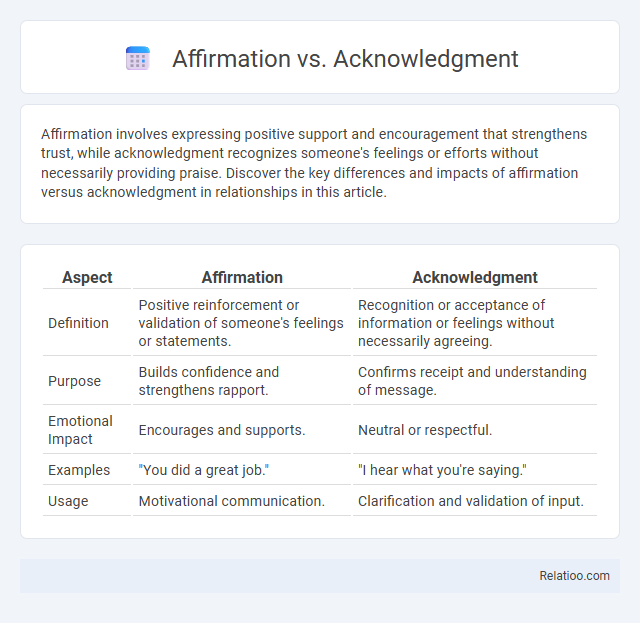Affirmation involves expressing positive support and encouragement that strengthens trust, while acknowledgment recognizes someone's feelings or efforts without necessarily providing praise. Discover the key differences and impacts of affirmation versus acknowledgment in relationships in this article.
Table of Comparison
| Aspect | Affirmation | Acknowledgment |
|---|---|---|
| Definition | Positive reinforcement or validation of someone's feelings or statements. | Recognition or acceptance of information or feelings without necessarily agreeing. |
| Purpose | Builds confidence and strengthens rapport. | Confirms receipt and understanding of message. |
| Emotional Impact | Encourages and supports. | Neutral or respectful. |
| Examples | "You did a great job." | "I hear what you're saying." |
| Usage | Motivational communication. | Clarification and validation of input. |
Understanding Affirmation and Acknowledgment
Understanding affirmation involves recognizing and validating your feelings or thoughts, reinforcing positive self-beliefs and confidence. Acknowledgment, on the other hand, centers on actively noticing and accepting facts, actions, or experiences without judgment, often to foster clarity and connection. Differentiating between these concepts helps you effectively communicate and nurture both self-awareness and interpersonal relationships.
Key Differences Between Affirmation and Acknowledgment
Affirmation involves a deliberate declaration that reinforces belief or support towards a statement, often aiming to strengthen confidence or validate a positive mindset. Acknowledgment, by contrast, is the act of recognizing or admitting the existence or truth of a fact, situation, or person's actions without necessarily expressing agreement or support. The key difference lies in affirmation's proactive endorsement versus acknowledgment's neutral recognition, making affirmation more about encouragement and acknowledgment about awareness.
The Psychology Behind Affirmation
The psychology behind affirmation reveals its powerful role in reinforcing positive self-beliefs and boosting mental resilience by consciously affirming one's values and capabilities. Unlike acknowledgment, which recognizes facts or emotions without necessarily influencing self-perception, affirmation actively shapes your mindset and emotional well-being by promoting self-acceptance and motivation. Understanding this distinction helps you use affirmation strategically to cultivate a healthier psychological outlook and improved emotional regulation.
The Role of Acknowledgment in Communication
Acknowledgment in communication validates the speaker's message and emotions, fostering trust and clarity between parties. Unlike affirmation, which expresses agreement or support, acknowledgment simply confirms receipt and understanding, helping Your conversations flow smoothly and reducing misunderstandings. Effective acknowledgment strengthens relationships by showing respect and attentiveness without necessarily endorsing the content.
Benefits of Practicing Affirmation
Practicing affirmation enhances self-confidence and fosters a positive mindset by reinforcing personal strengths and values. Unlike acknowledgment, which simply recognizes facts or emotions, affirmation actively shapes beliefs and motivates constructive behavior. Regular use of affirmations can reduce stress, improve resilience, and support emotional well-being.
The Impact of Acknowledgment on Relationships
Acknowledgment fosters trust and emotional connection by validating feelings and experiences, which strengthens relationships more effectively than simple affirmation. Unlike affirmation, which often expresses agreement or support, acknowledgment deeply recognizes and respects another's perspective, promoting empathy and open communication. Research shows that acknowledgment reduces conflict and increases relational satisfaction, making it a crucial factor in sustaining healthy interpersonal bonds.
Common Misconceptions About Affirmation and Acknowledgment
Common misconceptions about affirmation and acknowledgment often confound the two as identical expressions of recognition, but affirmation conveys deeper validation of feelings or identity, while acknowledgment simply recognizes facts or presence. Many believe acknowledgment is a lesser or insincere form of support, yet it serves as a crucial initial step in communication that validates experiences without necessarily endorsing emotions or actions. Affirmations are frequently mistaken as mere compliments or positive statements, overlooking their role in reinforcing personal worth and fostering psychological well-being through consistent, genuine support.
Practical Examples: Affirmation vs. Acknowledgment
Affirmation involves expressing positive support or validation, such as telling a colleague, "You did a great job on that project," which boosts confidence and motivation. Acknowledgment refers to recognizing facts or someone's input without necessarily conveying approval, for example, saying, "I received your email," to confirm communication. Practical use differentiates affirmation as an emotional encouragement tool, while acknowledgment functions as a neutral confirmation or recognition in professional and personal interactions.
When to Use Affirmation or Acknowledgment
Use affirmation to express strong agreement or positive reinforcement of a statement, belief, or feeling, particularly in therapeutic, motivational, or personal growth contexts. Acknowledgment is appropriate when recognizing the validity, presence, or existence of an idea, emotion, or fact without necessarily endorsing or strengthening it, commonly employed in professional, legal, or communication settings. Understanding the distinction ensures effective communication by applying affirmation to encourage and support, while using acknowledgment to validate and recognize information or viewpoints.
Tips for Balancing Affirmation and Acknowledgment in Daily Life
Balancing affirmation and acknowledgment in daily life enhances communication and emotional well-being by validating feelings while recognizing facts without judgment. Practice active listening to affirm emotions through empathetic responses, while offering acknowledgment by neutrally stating observations to maintain clarity and trust. Setting boundaries and reflecting on personal needs allow seamless integration of both techniques, fostering respectful interactions and self-awareness.

Infographic: Affirmation vs Acknowledgment
 relatioo.com
relatioo.com